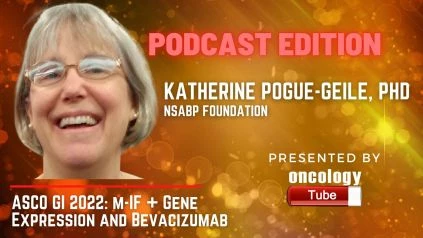Katherine Pogue-Geile, Ph.D., Assistant Director of Molecular Profiling at NSABP Foundation. In this video, she speaks about the ASCO GI 2022 Abstract – Multiplex-immunofluorescence (m-IF) and gene expression signature with prognosis and Bevacizumab (bev).
Â
Origins:
Â
In the NRG Oncology/NSABP C-08 study, individuals with stage II or III colon cancer were given bev in addition to mFOLFOX. We discovered that MMR status was predictive of bev benefit in an unplanned analysis, with dMMR pts having statistically significant bev benefit. We recently discovered that immune cells and immunological checkpoint proteins in C-08 mice had varied effects on prognosis and bev benefit (ASC0 2021). In dMMR and pMMR patients included in C-08, we investigated the association of VEGFR, VEGFA, and CD31 with clinical outcomes and treatment benefit as part of a preplanned secondary aim of an NCTN-CCSC approved protocol. We evaluated the 10-gene IFN signature (Ayers et al 2017), which has been linked to respond to ICB in other studies, to see which subgroup of pts in C-08 received bev benefit.
Â
Methodologies:
Â
m-IF and the Vectra Pathology System and inForm software were used to quantify VEGFR, VEGFA, and CD31 in tumors from C-08 pts (N=1,485). The IFN signature was tested for connection with bev benefit in dMMR and pMMR pts using gene expression data from C-08 (n=387) obtained by DASLR microarrays. Using recurrence-free interval, median cut points, and Cox models, all indicators were assessed for correlations with prognosis and bev benefit in dMMR and pMMR pts.
Â
Findings:
Â
In the whole C-08 cohort, as well as the dMMR and pMMR subsets, VEGFR, VEGFA, and CD31 were not predictive. High VEGFR, on the other hand, was linked to a bev advantage in dMMR patients (p=0.0012, HR=0.08 [95 percent CI; 0.025-0.224], n=117), but not in pMMR patients (n=555) (int p=0.03). Patients having a greater IFN signature in their tumors had a better prognosis than those with a low signature. Importantly, pts with low IFN signatures got bev advantage in the whole C-08 cohort with accessible DASL data (p=0.034, HR=0.59 [95 percent CI: 0.36-0.97], n=211). When low IFN tumors were further divided by MMR status, both dMMR and pMMR patients showed a trend toward bev benefit, but the numbers of patients were too small to draw definite conclusions (dMMR no bev vs. bev, p=0.02, n=11; pMMR no bev vs. bev, p=0.051, n=167).
Â
Outcomes:
Â
In dMMR patients, a high VEGFR is linked to a bev advantage. We discover that the IFN signature is related with a favourable prognosis in C-08, which is consistent with prior research; however, what is unique to this analysis is the finding that IFN low is associated with bev benefit across the entire C-08 cohort. The discovery that low IFN is related with bev benefit in C-08, as well as the correlation of high IFN signature with ICB response reported in multiple other trials, shows that bev and ICB are most efficacious on separate subgroups of pts. The current clinical trial, GI-004, is evaluating the efficacy of the combination of bev with atezolizumab. Examining these indicators could be instructive. Support: Pennsylvania Department of Health, U10CA-180868, -180822, -196067, Genentech, and Sanofi; NSABP. 00096278 is the number for the clinical trial.

